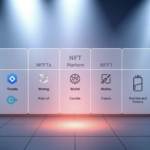Now Reading: Artificial Intelligence Blockchain Oracle Services Solutions
- 01
Artificial Intelligence Blockchain Oracle Services Solutions
Artificial Intelligence Blockchain Oracle Services Solutions

Oracles bridge a clear gap between on-chain code and the wider world. Smart contracts run deterministically, but they need trusted external data like price feeds, weather, or sports scores to trigger real outcomes.
At their core, a blockchain oracle logs requests on-chain while off-chain nodes fetch, verify, and return data. This pattern avoids heavy gas costs during retrieval and lets contracts act on reliable information.
Oracles are connectivity layers, not original sources. Robust designs aggregate multiple data sources and verification steps to reduce single points of failure. Providers such as Chainlink, Pyth, Band, UMA, and API3 show how mature offerings fit the ecosystem.
This Beginner’s Guide maps basic roles, common flows, trust models, and how modern systems include AI to improve data quality, latency, and cost. Understanding these fundamentals prepares you to evaluate secure, scalable integrations for real-world on-chain automation.
Key Takeaways
- Oracles solve the “oracle problem” by linking contracts to reliable off-chain data.
- Typical workflows use on-chain requests and off-chain nodes to fetch and return data efficiently.
- Robust implementations aggregate multiple sources to boost trust and reduce risk.
- Well-known providers demonstrate varied designs across the current ecosystem.
- Next steps cover patterns, trust models, risks, and AI-augmented pipelines.
Blockchain Oracles 101: How Smart Contracts Access Real‑World Data
To bridge the gap on-chain between isolated ledgers and live markets, specialized connectors bring off-chain information on-chain. Blockchain oracles act as that bridge, letting smart contracts react to events, prices, and APIs they cannot query directly.
What is an oracle and why the gap matters
A simple definition: an oracle transports real-world data into on-chain environments so contracts can execute based on external conditions. The on-chain/off-chain gap exists because contract code cannot call web endpoints, so an intermediary must fetch and validate answers.
How the flow works in practice
A common request-response pattern runs like this:
- A contract emits a request and an oracle contract logs the event.
- Off-chain nodes subscribe (e.g., via eth_subscribe), query apis and exchanges, then aggregate results.
- Nodes submit the verified value on-chain for the original contract to consume.
Types and trust models
Designs include immediate-read for static values, publish-subscribe for live feeds like FX, and request-response for single queries. Administration ranges from centralized operators to decentralized node sets and hybrid systems that trade simplicity for higher trust.
Artificial Intelligence Blockchain Oracle Services: Elevating Data Quality, Trust, and Performance
Newer systems combine statistical detectors and reputation math to raise the bar on data quality. These approaches protect smart contracts from bad inputs while keeping on‑chain costs low.
AI for data integrity: anomaly detection, outlier filtering, and dynamic reputation scoring
Models scan incoming values in real time to flag outliers and suspicious patterns. When a feed spikes or diverges from peers, filters block or mark the value before it reaches contracts.
Dynamic reputation scoring rates providers by accuracy, freshness, and consistency. Scores rise or fall as deliveries prove reliable, improving overall trust in results.

Trust by design and cost reduction
Off‑chain inference runs inside TEEs or uses zero‑knowledge proofs to attest that processing was honest. This keeps security tight without expensive on‑chain computation.
Predictive caching and adaptive update schedules cut latency and price. Hot values stay cached, and refresh rates tune to market activity, lowering gas and smoothing response times.
For a deeper technical view of these patterns, see AI-driven oracle pipelines.
Design Patterns and Integration: From Request‑Response to AI‑Enabled On‑Chain/Off‑Chain Architectures
Choosing the right feed pattern affects storage, gas cost, and responsiveness for contracts. Immediate-read returns static values with low gas use. Publish-subscribe keeps continuous feeds, ideal for FX and live markets. Request-response serves single queries and reduces on‑chain storage.
How these patterns map to data freshness and storage:
| Pattern | Freshness | Storage | Best for |
|---|---|---|---|
| Immediate-read | Low change | Minimal | Static price caps, config |
| Publish‑subscribe | High (continuous) | Indexed feeds | Market data, FX |
| Request‑response | On-demand | Transient | One-off lookups |
Modern stacks add verification layers that cryptographically attest input authenticity before smart contracts consume the data. Off‑chain compute can run NLP, CV, and model inference, then return compact, signed results.

aelf’s planned design blends on‑chain staking, reputation, cost settlement, an AI Agent Scheduler, and an AI Agent Factory with off‑chain TLS Notary nodes and SGX execution nodes. An SDK standardizes API interfaces to simplify integration for developers and protocols.
Security, Manipulation Risks, and AI‑Driven Defenses
Attacks that target price feeds and transaction ordering can quickly turn valid data into a vector for large losses. Protocols must treat external feeds and execution ordering as part of their threat model.
Common attack vectors include price feed manipulation via low‑liquidity pairs, short sampling windows, and single-venue reliance. Flash loans provide capital for intrablock swings. MEV frontrunning can change execution order and amplify impact.
Notable incidents show real risk. Inverse Finance used a thin INV‑WETH pair and a short TWAP to inflate collateral. An AaveV3 fallback bug allowed unauthorized price setting due to missing access control.

| Attack Vector | How it works | Practical mitigations |
|---|---|---|
| Price manipulation | Low liquidity or single venue feed skews prices | Decentralized aggregation, multi‑venue feeds |
| Flash loans | Large intrablock trades move markets temporarily | Longer sampling windows, conservative parameters |
| MEV frontrunning | Order reordering alters execution outcomes | Private mempools, slippage controls, monitoring |
AI‑driven defenses add anomaly detection and model validation to flag outliers before contracts act. Combine monitoring, reputation systems, strict access control, and audited integrations to restore trust across the ecosystem.
Real‑World Use Cases and Adoption Across the Web3 Ecosystem
Concrete integrations show how verified inputs turn code into live products. Real‑world data and provable randomness now automate settlements, payouts, and gameplay without manual steps.

DeFi price feeds and trading algorithms
Major protocols rely on accurate price feeds from Chainlink, Pyth, Band, and UMA to manage collateral, liquidations, and automated trading. Trusted feeds keep lending rates and options settlement in sync with markets.
Verifiable randomness for games and lotteries
Services like Chainlink VRF and API3 QRNG provide provable randomness. That guarantee is critical for fair games, lotteries, and NFT minting where outcomes must be indisputable.
Event‑driven automation
Parametric insurance uses flight delay and weather data to trigger instant payouts. When a verified feed reports a covered event, contracts pay claims without dispute or manual review.
Supply chain and beyond
AI‑enhanced oracles analyze invoices and sensor images to validate provenance and detect counterfeits. APIs, exchanges, sensors, and official datasets are aggregated and validated as trusted sources for these applications.
Result: diversified sources, standardized feeds, and integration tooling speed adoption. Together, these systems enable new on‑chain applications across finance, insurance, gaming, and logistics.
Your Path Forward: Getting Started with AI‑Enhanced Oracles Today
Start with a clear inventory of the data points, latency limits, and failure modes your application can tolerate. Map which smart contracts need which external data and how often updates must arrive.
Choose providers that offer decentralized aggregation and solid documentation. Pick an integration pattern—request‑response or publish‑subscribe—and use provider SDKs and apis for fast development.
Run off‑chain analysis with TEEs or attestation to add anomaly detection and reputation scoring. Add monitoring, circuit breakers, and strict access controls to reduce manipulation risk and boost security.
Plan a staged adoption: proof of concept, testnet trials, then phased mainnet rollout. Treat these systems as core parts of your architecture and maintain continuous audits to preserve trust and uptime across the network.














